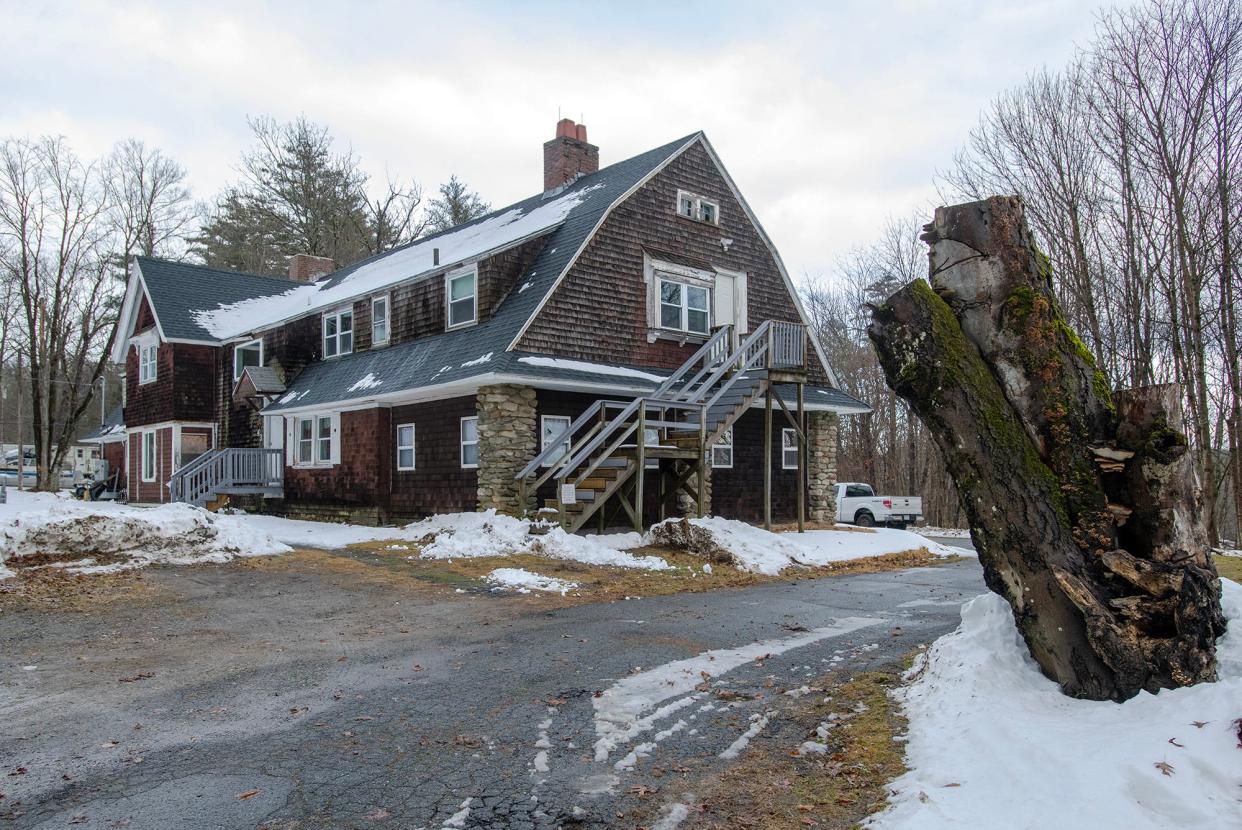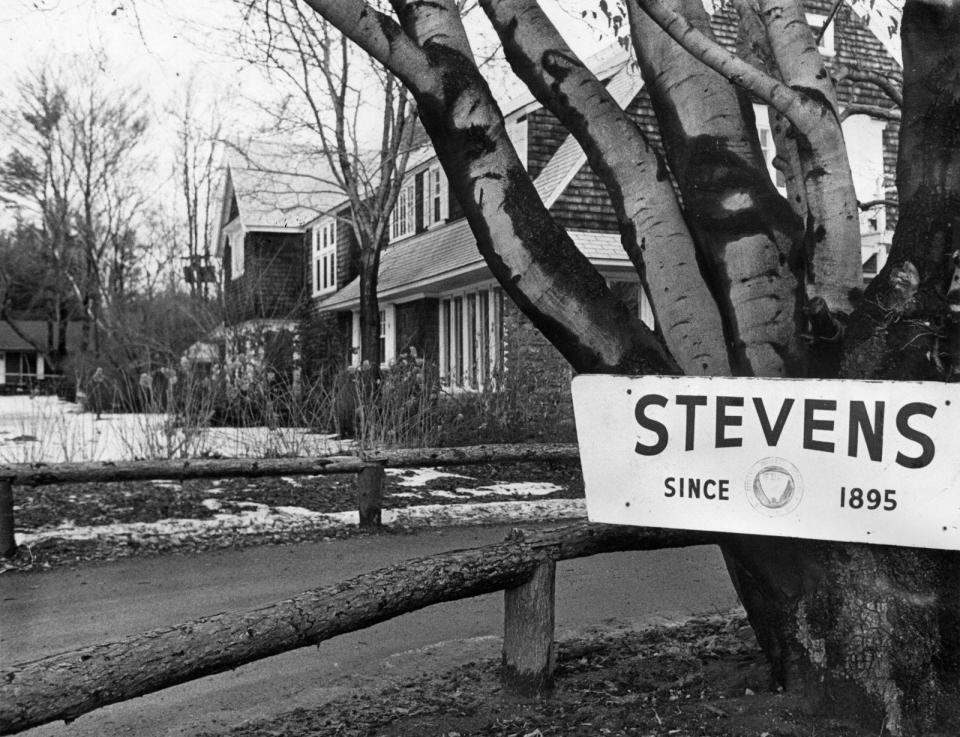Then & Now: Stevens College, Morgan Road, Hubbardston


A 660-acre farm in Hubbardston, for years a summer getaway for the family behind Morgan Construction in Worcester, was bought in 1969 by a small business college in Fitchburg.
Stevens College, dating to 1895, had mapped an ambitious growth plan that called for the unloading of its spot on South Street in Fitchburg and creating a new campus, one worthy of its goal of becoming a four-year liberal arts college.
One of the school officials who pushed for expansion was Frank DiPietro, a Fitchburg native credited with the founding of Franklin Pierce College in New Hampshire. He was president of Stevens in the mid-1950s.
Stevens officials scoured the region for suitable land, at one point soliciting selectmen from various communities to make a pitch. Eventually, the school shifted its focus to Morgan Farm on Morgan Road in Hubbardston, a sprawling tract with a pond (Waite Pond) and a handful of buildings, namely what was known as "The Big House" at 41 Morgan Road, pictured in this week's Then photo, from 1972.
About 1900, the land was bought by Paul B. Morgan, whose ancestors (and descendants) owned and ran Morgan Construction in Worcester. Family members used houses on the property as summer homes. The farm abuts state-owned conservation land.
Much of the farm was sold to a Worcester lawyer in 1968, and in April 1969 he sold it to Stevens College for $243,500.
The purchase was a major step in an expansion blueprint pushed by Stevens College President Paul R. Maynard. Originally part of a chain of business training schools, with a location in Fitchburg, the school operated for decades as Stevens Business College. After years of trying and a bit of behind-the-scenes handiwork, the school said it got the state's OK to switch to a four-year school.
The reception in Hubbardston was mixed, with some residents fearing a disruption of the town's peaceful atmosphere.
But one town official, Frank Washburn Jr. of the Planning Board, was quick to endorse the school, mindful of an earlier instance in which Hubbardston turned away a college proposal. Jonas G. Clark, who grew up in Hubbardston in the early 1800s, is said to have considered his hometown for a college he envisionied. Instead he chose south Main Street in Worcester for the school that would carry his name.
At the former Morgan Farm, a dormitory and classroom buildings were built in the summer of 1969.
The seclusion of the new campus, with a pond and hiking trails, was part of the school's pitch to prospective students. "The Big House," a gathering spot for generations of Morgans, was converted into a women's dormitory. One of the barns on the property was converted into a recreation hall. (The same barn was moved to the property from the town of Dana years earlier. Dana was flooded to create the Quabbin Reservoir.)
It didn't take long for Stevens College officials to realize that its new campus might not have as many suitors as once thought. For the first semester in Hubbardston, fall 1969, enrollment was at 147, down from the 170 of the previous semester when the school was in Fitchburg. It was a similar scenario faced at the time by many private liberal arts colleges, let alone one that had yet to establish a reputation on which it could rely.
By the fall of 1970, enrollment at Stevens had dropped to 106. The five-year goal of 1,000 students suddenly seemed overly optimistic.
Soon, Stevens College was in talks with Northeastern University and UMass Amherst about a possible takeover or partnership.
Behind the scenes, Stevens College administrators and faculty were at odds. Neil M. Wriedt, a retired Army colonel who took over as college president in July 1969, was gone within months. An instructor was fired after publicly airing complaints about a lack of facilities and overworked staff.
With enrollment projections far from being met, the school fell behind on payments to contractors and on its mortgage, held by Gardner Savings Bank.
In early January 1972, with the second semester nearing, the school's remaining 47 students were notified that Stevens was closing. On Jan. 13, with creditors pressuring for payment, the school sold much of its property at auction. A month later, the school filed for bankruptcy, claiming $750,000 in liabilities.
Stevens was gone for good. Some students were able to transfer credits to Becker Junior College, a school that would see its own demise in 2021.
The old campus gained interest in the real estate market. And it would soon be at the center of debate in Hubbardston. In early 1972, the land was bought by Reclamation Systems, a Cambridge company that was in search of a spot to develop a landfill for Boston-area trash.
Hubbardston residents voiced strong oppositon to the proposal. A 500-signature petition was gathered within hours.
Eventually, the landfill was taken off the table.
Meantime, the farm has been privately owned and divided over the years. "The Big House" was reworked into apartments and had fallen into disrepair over the years. There was a significant fire on Christmas 2011.
The updated house and former dorm across Morgan Road are now owned by Tegra Properties of Fitchburg.
Last week Then & Now: Land & Sea Foods, Pleasant Street, Worcester
This article originally appeared on Telegram & Gazette: Then & Now: Stevens College, Morgan Road, Hubbardston

